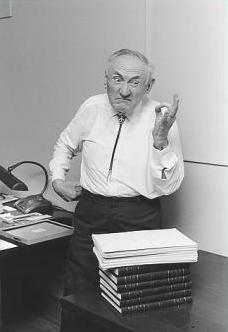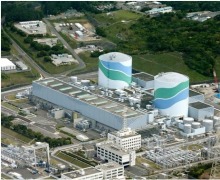
Blog
-
Geiger Readings for July 14, 2014
My Geiger counter is in the shop for maintenance. -
Geiger Readings for July 13, 2014
My Geiger counter is in the shop for maintenance.
-
Geiger Readings for July 12, 2014
My Geiger counter is in the shop for maintenance.
-
Wild Ideas for Using Nuclear Bombs to Terraform the Planets
At the dawn of the Atomic Age, there was talk of using nuclear bombs for civilian purposes such as digging canals and harbors. In the Soviet Union, there was even a plan to use nuclear bombs for fracking natural gas. Fortunately this plan was never carried out. However, it turns out that these proposals were tame in comparison to ideas expressed by an astronomer named Fred Zwicky at CalTech.
Zwicky was the first astronomer who conceived of dark matter, supernovae and neutron stars. He presented many advanced theories in academic articles, newspaper interviews and magazine articles between the 1940s and the 1960s. He was highly critical of his fellow scientists. He felt that they lacked vision to really make use of advanced technologies. He once said that “Astronomers are spherical bastards. No matter how you look at them they are just bastards.”
One of his ideas was something called a “terrajet.” He claimed that it would make it possible to send missiles directly through the Earth to attack an enemy from beneath. He envisioned that the terrajet would gather rock and dirt in and then blow it out through an exhaust system as they tunneled.
Zwicky had a plan to colonize the solar system with nuclear bombs. He thought that Venus and Mercury could be moved further away from the sun into the habitable zone with a series of nuclear explosions. He also had the idea to use nuclear bombs and the terrajet to reduce the size of Jupiter to the point where it could be inhabited. The debris left over from carving up Jupiter was to be added to the moons of Jupiter to make them more suitable for colonization.
If a planet or a moon lacked sufficient atmosphere, he thought that the terrajet earth borer could produce oxygen and water as byproducts of digging channels for lakes and rivers. If a planet or moon had a poisonous atmosphere, nuclear bombs could be used to blow it off. He claimed that it should be possible to build nuclear bombs that would not create a high level of radioactivity when detonated. This would mean that the planets that were terraformed with nuclear bombs would not be rendered uninhabitable by radiation generated by nuclear explosions.
As wild as these ideas are, Zwicky had even more outrageous plans for space exploration. He claimed that it should be possible to accelerate the sun by triggering nuclear fusion reactions on the surface of the sun. Properly positioned, such reactions would cause the sun to eject huge solar flares that would impart momentum to the sun. This was to be accomplished by injecting particles of the proper composition and size into the sun to trigger the reactions. As the sun was accelerated in a particular direction, it would drag the planets along with it. So, in essence, the whole solar system would become a sort of spaceship.
It will be decades or more before these ideas are even theoretically possible whether or not they are a good idea.
Fred Zwicky:
-
Radiation News Roundup July 11, 2014
The Indian government has announced an increase of almost 27% in its budget for atomic research and nuclear power for the latest fiscal year. world-nuclear-news.org
Federal regulators are investigating a nuclear fuel facility in Tennessee following a report that safety-related valves were propped open. nuclearstreet.com
-
Geiger Readings for July 11, 2014
My Geiger counter is in the shop for maintenance.
-
Nuclear Reactors 144 – Japan Struggles to Turn Nuclear Reactors Back On
I post four links of nuclear related news each day. I have posted many links to articles about the Fukushima disaster in March 2011 in Japan. Today I am going to write about events in the attempt to restart the fifty four idle Japanese reactors in spite of widespread public opposition. Prime Minister Abe has made expanding nuclear power and exporting nuclear technology a centerpiece of his plans to revitalize the Japanese economy.
After the disaster at Fukushima, all the nuclear power reactors in Japan were turned off. There was a serious review of what happened at Fukushima. A new regulatory agency called the Nuclear Regulatory Agency was created to handle nuclear power plants. New safety regulations were drafted and a review of geological faults under nuclear plants was carried out. Individual nuclear plant operators are currently petitioning the government for permission to restart their nuclear reactors. Japan is paying higher prices for electricity with the reactors shut down.
One of the major problems with the Fukushima disaster was the fact that their emergency control center was too close to the reactors. It suffered radioactive contamination and communication equipment failures that made dealing with the disaster much more difficult.
One of the new rules that was passed after Fukushima mandates that all nuclear power plants have off-site emergency control centers. These control centers are supposed to be located between three miles and eighteen miles away from the power plant. The control centers are to be equipped with ventilation and other protective systems to prevent radioactive contamination during emergencies. There are also supposed to be multiple emergency centers in each prefecture so that if one center is crippled in an emergency, another control center can take over. The deadline for construction of the emergency centers is September 2015.
Kagoshima prefecture has reported that the construction of an emergency center for the Sendai plant is behind schedule. They say that discussions with the Japanese central government are responsible for the delay. They say that an ventilations system and emergency power generator will be in place by March of 2015. A backup facility for the emergency control center is scheduled for completion by October of 2015. There is already a backup control center for the Sendai plant so it should be able to start operating in the autumn of 2015 if it passes the NRA safety review. The emergency centers are not part of the NRA safety review.
The construction of emergency control centers for nuclear power plants around Japan has suffered numerous delays. There are existing emergency control centers at some nuclear power plants but they will have to be moved to be at least three miles away from the power plant.
The new regulations are a good start at preventing another Fukushima disaster. Only time will tell if the companies operating the nuclear power plants and the Nuclear Regulatory Agency will adhere to the new standards. Given problems with corruption and incompetence in the Japanese nuclear power industry in the past, these new regulations may not be effectively implemented and monitored.
Sendai nuclear power plant:
-
Radiation News Roundup July 10, 2014
Newly released data shows 4,000% more radioactive material in Fukushima groundwater than TEPCO claimed. enenews.com
Stanford professor is very worried about Fukushima radiation threatening the U.S. West Coast. enenews.com
The Slovenian government has approved an investment program for a national repository for low- and intermediate-level nuclear waste . world-nuclear-news.org
The Tajikistan government plans to approve a decade-long study of uranium in rare earth deposits starting next year. world-nuclear-news.org

